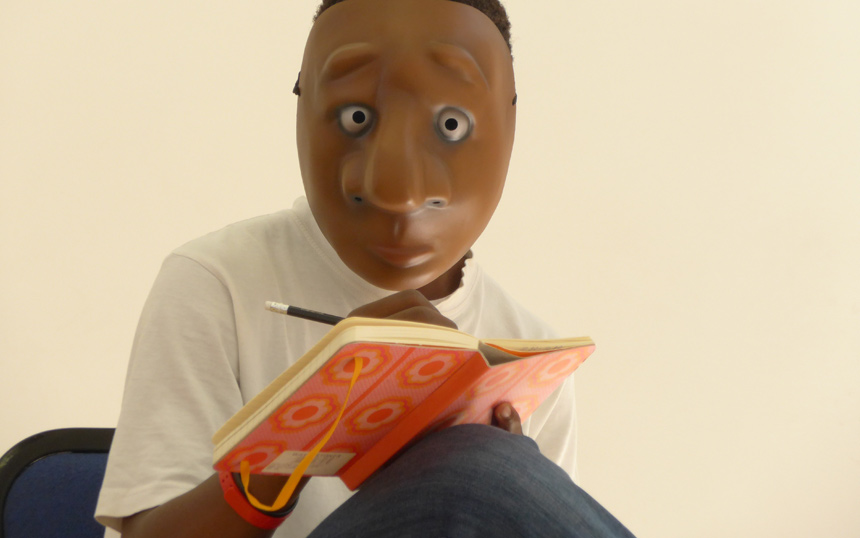This March Janie and I set out for a British Council/Arts Council funded venture to South Africa to share our full mask skills with young people and professionals and explore new collaborations and partnerships. We learnt so much; about our teaching methods, about full mask in a different culture, and about South Africa’s history, culture and politics.
But there is one story that has affected us more than any other - the abandonment of babies in South Africa. With all our work and research for the The Best Thing over the last three years, the connection between abandoned babies today in South Africa, and forced adoption in 1960s Britain, seems to have frightening parallels.
We were working in Hillbrow, an inner city area of Johannesburg with high levels of population density, unemployment, and poverty. Everywhere we looked posters stated “Abortion- same day, pain free.” When we asked about them further, we learnt a little more of the truth behind these tatty, white A4s. Now I’ve come home and fallen into an intrigue of research. Let me share with you what I’ve discovered; through talking to people, through meeting beautiful adopted children, through reading through a heart-rending report from the National Adoption Coalition in South Africa, written in 2014; “There are 18.5 million children in South Africa. Of these children, 4.5 million live with neither of their parents. Orphans have increased by 30% over the decade to approximately 5.2 million children.”
My findings do not make easy reading...you have the option to stop here.
As with The Best Thing, our first question was about the mothers - why are mothers separated from their babies? And today, in South Africa, why do mothers abandon their babies? Which has taken me further back to ask why do they get pregnant? Young, pregnant girls are increasingly being demonised, and language attached to the problem includes words like “skyrocketing”; “crisis”, “out of control”; and “epidemic.” Research has shown that girls getting pregnant are getting younger and younger, and by implication, more innocent; and that intergenerational sex is cited as the primary cause of teenage pregnancy: “20% of teen pregnancies [sic] result of rape and 60% of pregnant teens claim to being [sic] coerced into having sex by older men” (Mail & Guardian 03/02/2012).
In 2012 an Outdoor billboard from the KZN Department of Health lead a campaign that read, “Older Men + Young Girls = Teenage Pregnancy & Aids – Sugar daddies destroy lives." And yet, it’s the young mothers who are poorly portrayed in the media and seen as the guilty party. This portrayal is supported by the current political leadership, with President Zuma referring to teenage mothers as “indulged”, “irresponsible”, and “having no self-respect” (National Adoption Coalition). You may have read in the news about President Zuma’s antics, but that’s a different story...
Other causes of teenage pregnancy include poverty, rape, drug and alcohol abuse, proving one’s fertility, grant dependency and peer pressure. In the media, the National Adoption Coalition identifies “a distinct, graphic style of photography used to portray teenage pregnancy, specifically a faceless, disembodied pregnant belly in school uniform.” With The Best Thing we aimed to give mothers from the 1960s a voice; I doubt that the voice of these young mothers in South Africa will ever be heard. There seems to be extreme gender inequality, with high levels of gender-based violence and rape, as well as cultural beliefs that babies should not be given away; they are a gift from their ancestors, and mothers will be punished for giving up a child. “Adoption is not an option as it is believed that the child is born spiritually linked to rituals peculiar to that ancestry, and a cross-pollination of rituals will anger the child’s ancestors and cause all sorts of misfortunes for the child, including sickness and disease” (Sipokazi Poswa-Lerotholi, The Times (South Africa), 20/01/2012).
And so where can a young mother turn to, where can she go? Her family rejects her, the father of the child probably doesn’t hang around. If she follows the responsible root of legal adoption, she lives with the threat that her ancestors punish her. National Adoption Coalition research cites instances where living in extreme poverty, and just surviving from one day to the next, strips the mother of her ability to love her child, and they posit that many mothers disconnect themselves from their babies as a “survival strategy”, to protect themselves from the trauma of losing a child.
Anonymous abandonment of the baby, or back street abortion, are the options left. Legal abortion remains a contentious issue, with girls being labelled as immoral. Illegal, backstreet abortions apparently are unsafe, and botched abortions are reported frequently. Abandonment has been criminalised, with mother’s facing a range of charges such as concealment of birth and attempted murder. So mothers abandon their babies anonymously, desperately needing to hide their “crime.” Abandoned children are portrayed as innocent victims, in contrast to their guilty mothers.
No statistics exist, but the National Adoption Coalition talks of a review of reported abandonments which indicates that: 65% are new born, 90% are younger than a year and 70% of abandonment sites cited are unsafe. The number one mentioned site of abandonment is toilets, drains, sewers and gutters. The luckier ones are abandoned in a hospital, on a door step, or in a baby safe. A baby safe had just opened in Hillbrow where we were working: it’s a hole in a wall where the baby can be safely placed on a soft platform, and left anonymously. These too are illegal, but are an attempt to keep babies alive. The majority of abandoned children are thought to die, however. Again, no formal statistics exist: “of the 200 abandoned babies found in Johannesburg and Soweto monthly, only 60 are found alive” Omphitlhetse Mooki and Kutlwano Olifant, The Star 02/05/2012).
I read and discovered more, but find it all too shocking to add. What brought home this problem so strongly was that we met children whilst staying in Johannesburg; children who have been adopted into the most loving and caring homes; polite, playful, respectful, adorable and intelligent children. It was the question from one father that hit home hardest...
“What do I tell them?”
“Tell them that you love them.”
We went to South Africa to find connections; and we found a powerful one. So what now; what do we do with it? My heads ticking with future plans, ideas and potential partners in Jo’burg and Cape Town…the story continues.
Rachael
Rachael's trip to South Africa was funded by The British Council and Arts Council England through the International Artist Development Fund

